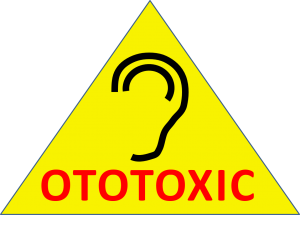Ototoxicant Chemicals and Workplace Hearing Loss
Posted on by

Since the 19th century, many therapeutic drugs have been known to affect hearing. Known as ototoxic drugs, many are used today in clinical situations despite these negative side effects because they are effective in treating serious, sometimes life-threatening conditions. Research has shown that exposure to certain chemicals in the workplace may also negatively affect how the ear functions, potentially causing hearing loss or balance problems, regardless of noise exposure. Substances containing ototoxicants include certain pesticides, solvents, metals and pharmaceuticals. The risk of hearing loss they pose can be increased when workers are exposed to these chemicals while working around elevated noise levels. This combination often results in hearing loss that can be temporary or permanent, depending on the level of noise, the dose of the chemical, and the duration of the exposure. This hearing impairment affects many occupations and industries, from machinists to firefighters.
A new informational bulletin developed by OSHA and NIOSH raises awareness of this issue, provides examples of ototoxic chemicals, lists the industries and occupations at risk and provides prevention information. The hearing loss caused by chemicals can be very similar to a hearing loss caused by excessive noise. The fact that noise exposure is so common in modern societies might explain the delay in recognizing the risk to hearing that these chemicals can pose. Pure tone audiometry is a basic clinical test used to determine a person’s hearing sensitivity at specific frequencies, i.e., the softest sound that can be perceived in a quiet environment. It clearly identifies various hearing loss characteristics, but not its cause. Other hearing tests such as word recognition or otoacoustic emission tests examine other auditory functions. In some cases, these tests can help differentiate the effects of chemicals from the effects of noise, since chemicals might affect the more central portions of the auditory system (nerves or nuclei of the central nervous system, the pathways to the brain or in the brain itself). These hearing deficits may have a more pronounced impact on the worker’s life because not only are sounds be perceived as less loud, but also as distorted. Word recognition may be compromised, particularly in background noise, making it difficult, for instance, to hold a conversation in a busy restaurant or at a party.
The first step in preventing exposure to ototoxicants is to know if they are in the workplace. The publications cited in the bulletin identify known ototoxicants for example: toluene, styrene, carbon monoxide, acrylonitrile, and lead. When there is no information on a certain chemical’s ototoxicity, information on the chemical’s general toxicity, nephrotoxicity, and neurotoxicity may provide clues about the potential ototoxicity. Most chemicals that are known to affect the auditory system are also neurotoxic and/or nephrotoxic. One can review Safety Data Sheets (SDS) for ototoxic substances and/or chemicals, and ototoxic health hazards associated with ingredients in the product. For example, Figure 1 shows an SDS where ototoxicants may be in a product.

NIOSH continues its research on this subject, in collaboration with several partners, including France’s Research and Safety Institute (INRS) and other institutions in the U.S., Canada and China (Fuente et al., 2018). For more information, see the recent paper in the Journal of the Acoustical Society of America, “Use of the Kurtosis Statistic in an Evaluation of the Effects of Noise and Solvent Exposures on the Hearing Thresholds of Workers: An Exploratory Study”
For more information on risk factors for hearing loss please visit the NIOSH Noise and Hearing Loss Prevention topic page.
Update: Since this blog posted, a new study was published (Dement 2018) which examined work history, health behavior, and hearing test results from more than 19,000 former construction workers to identify factors contributing to hearing loss. The researchers found that exposure to exposure to organic solvents along with exposure to loud noise on the job, and smoking each increased a worker’s risk of hearing loss by 15-20%. The prevalence of hearing impairment and risk ratios varied across sites and trade groups, which was accounted by the difference in exposure and other risk factors. Those who do not have access to the journal article can contact the author at john.dement@duke.edu. Key findings were summarized by the CPWR – The Center for Construction Research and Training.
Thais C. Morata, PhD, is a research audiologist with the NIOSH Division of Applied Research and Technology and the Coordinator of the NORA Manufacturing Sector Council.
CAPT Chuck Kardous, MS, PE, is a senior research engineer with the NIOSH Division of Applied Research and Technology.
Reference
Fuente A, Qiu W, Zhang M, Xie H, Kardous CA, Campo P, Morata TC. Use of the kurtosis statistic in an evaluation of the effects of noise and solvent exposures on the hearing thresholds of workers: An exploratory study. J Acoust Soc Am. 2018 Mar; 143(3):1704. https://doi.org/10.1121/1.5028368
Dement J, Welch L, Ringen K, Cranford K, Quinn P. Hearing loss among older construction workers: Updated analyses. AJIM. 2018 April:61(4): 326. https://doi.org/10.1002/ajim.22827
Posted on by

